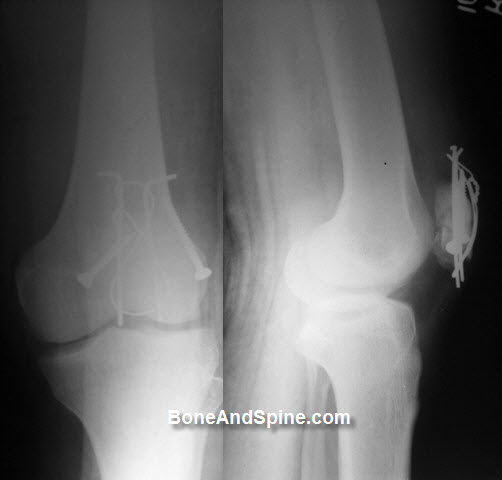Last Updated on October 29, 2023
Tension band principle was given by Pauwel. Tension band converts tensile forces to compression forces on the convex side of an eccentrically loaded bone. This is accomplished by placing a tension band (bone plate or wire loops) across the fracture on the tension (or convex) side of the bone to convert tension forces into compressive forces.
A tension band can produce compression statically or dynamically. If a tension band produces fairly constant force at the fracture site during motion, such as at the medial malleolus, it is called a static tension band. Conversely, if the compression increases with motion, such as in the patella with knee flexion, the tension band is called dynamic.
Clinical Application of Tension Band Principle
Tension band principle is utilized in the application of plate fixation and tension band wiring.
The aim of fixation by the implant is the sound union of the fracture fragments. For this to achieve, the implants need to be fixed on the bone so that an optimal milieu for fracture healing is created.
a curved bone has a compressive or convex surface and a tensile or concave surface.
A bone has a compressive surface where the compressive force acts along the long axis of a bone so as to compress the bone material when the bone is loaded.
The concave surface of the bone is the compressive surface.
A force that pulls apart both the axial ends is an example of tensile force. For tensile force to result in fracture, one end of a bone must be in a fixed position while the other end is forced away from the fixed end.
If the plate is applied to the compression or concave side of the bone, the compression forces over the period would cause bending, fatigue, and failure of the implant.
Therefore the implant must be applied to the tension side of the bone.
This implant on the tension side neutralizes the forces under an axial load.
[A prerequisite is that there must be cortical contact on the compressive side otherwise the implant will undergo bending stress and be subjected to early fatigue failure.]
The concept can most easily be understood by examining the femur under mechanical load.
- Under axial load, the curved femur creates a tension force laterally and a compression force medially.
- A plate on the compressive surface would not be able to neutralize the tension force and should not be applied in this position.
- A tension band plate neutralizes the tensile forces on the tension surface and converts tensile force into compression on the opposite cortex.

Clinical Application of Tension Band Principle
The application of a tension band neutralizes the tensile forces and even convert them into compression. This principle is used in the surgical treatment of many fractures.
Patella

Tension band principle applied to a fracture of the patella. The figure-of-eight wire loop lies anterior to the patella and fracture. Upon knee flexion, the tensile force (between the quadriceps muscle and the tibial tuberosity) is converted into compression at the articular surface.
Olecranon fracture
The figure-of-eight wire loop acts as a tension band during flexion of the elbow. This is an example of a dynamic tension band.
Avulsion of the greater Tubercle of Humerus
The wire loop is anchored to the humerus by a 3.5 mm cortex screw.
Medial malleolus
The wire loop may be anchored to the tibia by a 3.5 mm cortex screw. This is an example of a static tension band.
Plating/External Fixation in Diaphyseal Fractures
In curved long bones, the convex side of the diaphysis indicates the tension side.
A plate or external fixator that functions according to the tension band principle must be applied to the tension side of the bone or the convex side of a deformity or nonunion.
Static and Dynamic Tension Band
A tension band that produces compression at the time of application is called a static tension band, as the forces at the fracture site remain fairly constant during movement.
For example – Tension band application to the medial malleolus
A tension band that increases the compression force increases with motion is dynamic tension band.
For example – the tension band wiring of a fracture of the patella. Upon knee flexion, the increased tensile force is converted to a compression force.